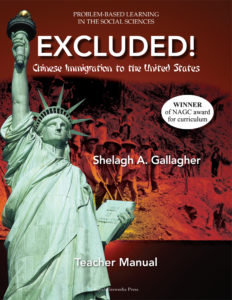Sign in for exclusive products and special discounts.
Excluded! Problem-Based Learning Unit
Chinese Immigration to the United States
NAGC Curriculum Award-Winner!
This unit focuses on the Chinese exclusion laws, which were enacted in the 1880s to prevent further Chinese immigration in the United States. Students take on the role of government officials trying to decide whether to support the Geary Act. They must investigate a variety of issues related to immigration and decide what to do to solve the problem of the influx of immigrants to the U.S.
In This Series
Description
National Association for Gifted Children Curriculum Award-Winner!
This unit focuses on the Chinese exclusion laws, which were enacted in the 1880s to prevent further Chinese immigration or settlement in the United States. Students take on the role of government officials, using values and priorities that represent concern for the public good. They investigate how and why the Chinese exclusion laws came into being from the vantage point of Congressmen and -women from California trying to decide whether to support the Geary Act.
The students are forced to consider what reasonable limits can or should be placed on immigration in a country that urges, “Give me your tired, your poor, your huddled masses.…” To understand the background, students investigate why Chinese immigrants first came to America, the rate of Chinese immigration, changing attitudes toward Chinese immigrants, the initial Chinese exclusion law, and Supreme Court decisions supporting that act. They are faced with conflicts between the rights of citizens versus those of immigrants, the fact that Chinese were recruited to America, and the similarities and differences between Chinese and other immigrant groups.
Ultimately the students must decide what to do to solve the problem of the influx of immigrants as they ponder the short- and long-term consequences of their decision. This unit is especially relevant to the current conversation on immigration to the United States, and students will draw powerful parallels to contemporary immigration issues.
Details
- Curriculum
- Problem-Based Learning
- Ages
- 14, 15, 16, 17, 18, Teachers & Schools
- Grades
- 9, 10, 11, 12
- Subjects
- History, Problem-Based Learning, Problem-Solving
- Formats
- Series
- Downloadable Materials
- Yes














